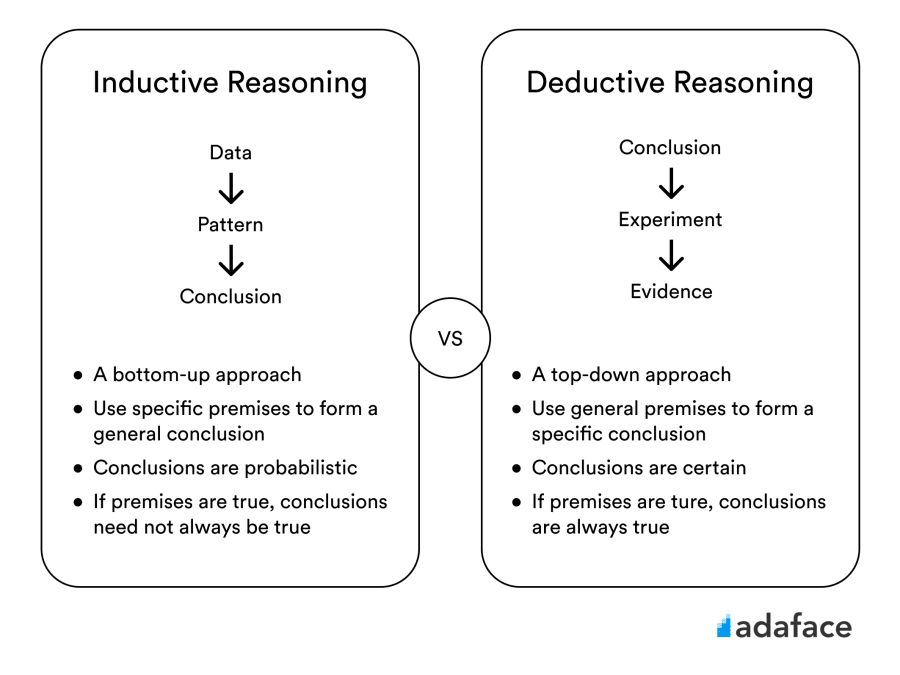

For most roles that you hire, you want candidates to have a problem-solving ability, don't you? We all do. It is one of the most critical skills to have that predicts success in the workplace.
The path taken in problem-solving is a direct predictor of a candidate's ability to solve problems.
The logical problem-solving approach has two paths which can be taken: a bottom-up approach or a top-down one. While the bottom-up approach focuses on developing a generic conclusion, the top-down one tests the generic conclusion.
These two paths make the two methods of reasoning, Inductive & Deductive Reasoning.
As we move forward, we explore each reasoning methodology and why they play a critical role in our everyday jobs. We also see examples of using these skills on the job and how you can test them during hiring.
Let's dive right in.
What is Inductive Reasoning?
Inductive Reasoning is a method of reasoning in which specific scenarios are considered to come up with broad conclusions.
For example: John is a basketball player. All basketball players that I have seen are over 6ft tall. John must also be over 6ft tall.
John does not have to be over 6ft tall to be a basketball player. However, based on the specific scenarios evaluated by the observer, the fact that John must also be over 6ft tall is a generic conclusion. Still, it need not necessarily have to be a valid one.
Inductive Reasoning in the Workplace
Most jobs require candidates to be able to reason through an inductive approach. You may not have explicitly tested for the ability, but there is a good chance you expect the candidate to have this skill set.
This is because many jobs today, particularly in the tech industry, require you to observe data patterns, whether employee feedback, a user experience survey, or market analysis, and make broad generalizations. You then use these generalizations to make future business decisions.
As a matter of fact, as a hiring manager, you always use an inductive approach in your hiring decisions. You test your candidates on various parameters such as personality tests, technical and aptitude rounds, and interview rounds and gather all the information. By using all the information that you have gathered, you conclude how capable that particular person is for the job.
Examples of Inductive Reasoning in the Workplace
- Develop new product features based on the way users react to your product.
- Decide on employee incentives based on feedback from your employees.
- Determine when you leave home for work based on your daily experience with traffic.
- Plan all the project tasks to complete them within the deadlines provided.
What is Deductive Reasoning?
Deductive Reasoning is a method of reasoning in which broad conclusions are validated using specific scenarios.
For example: All numbers divisible by 10 end with a zero. 40 ends with a zero. 40 is divisible by 10.
The final statement is a valid conclusion based off of the first two specific statements, i.e. the conclusion cannot be deemed false as long as the first two statements stay true.
Deductive Reasoning in the Workplace
Most job descriptions mention a key requirement—an excellent problem-solving ability.
Problem-solving ability and deductive reasoning go hand in hand. A candidate with a good deductive reasoning approach to problems is inherently good at solving problems.
In most technical or engineering jobs, a deductive approach to problem-solving is used. These jobs require you to develop accurate and valid solutions based on the information provided.
Examples of Deductive Reasoning in the Workplace
- Determining the most effective go-to-market strategy based on your user base.
- Develop a pricing strategy by doing a complete user and competitor analysis.
- Determine the reason for decreased sales and find the most optimum solution to the problem.
Inductive vs Deductive Reasoning - Differences
While both methods of reasoning are used to solve a variety of problems, the approach to problem-solving is different for each method.

How do you Test for Inductive & Deductive Reasoning?
We've already discussed why the ability to reason inductively and deductively is important in the workplace. Since we cannot gauge these skills through a resume or a LinkedIn profile, what are the different ways you can test for these skills during your hiring process?
Use Valid Pre-employment Tests
Pre-employment tests are an excellent way to obtain evidence about the extent to which a candidate possesses these abilities. Tests specifically designed to assess inductive and deductive reasoning abilities, such as the Adaface Inductive Reasoning and Deductive Reasoning Tests, can provide an accurate estimate of your applicant's problem-solving approach.
It gives these soft skills a quantifiable value. It allows you to compare the performance of a pool of candidates, thus eliminating those who fall below a certain threshold.
Ask the Right Interview Questions
Candidates can easily answer inductive and deductive reasoning questions pulled off the internet by simply googling them and practising a little before their interview. However, asking the right interview questions can help you determine their ability and approach to solving problems.
Instead of giving them problems to solve in an interview, ask them to describe their approach to a problem they have already solved, be it in a previous job or university. Ask them to elaborate on why they came up with the solution and how they did it. Candidates have to give answers to such questions spontaneously without any prior preparation to them. This allows you to predict how they will approach any problems that arise on the job.
On a Final Note
Soft skills such as inductive and deductive reasoning will always be in demand in every job you are hiring for. By choosing the right methods to test for these skills, you can help your organization choose the perfect candidate for every role.
As a matter of fact, both of the above methods can be effective in your hiring process. Pre-employment tests can serve as an elimination tool to remove candidates who score below a chosen minimum, and by asking the right interview questions, it can serve as a selection tool to help you choose the most suitable candidate for your organization.
FAQs
1. What is the difference between Inductive and Deductive Reasoning?
The key difference between Inductive and Deductive Reasoning is that the former works on developing a general theory while the latter works on proving an already existing theory.
2. What is an example of Inductive Reasoning?
Premise: It rains almost ever year during the month of July. Conclusion: This July, it is probably going to rain.
3. What is an example of Deductive Reasoning?
Premise: All cats walk on four legs. Persian cat is a cat breed. Conclusion: Persian cats walk on four legs.

Pragnesh is the EiR at Adaface. He loves reading books more than scrolling through social media, which is a big deal if you ask him.
Spending too much time screening candidates?
We make it easy for you to find the best candidates in your pipeline-
with a 40 min skills test.


